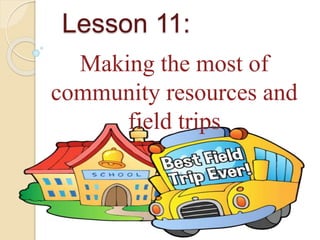Lesson 11
- 1. Lesson 11: Making the most of community resources and field trips
- 2. “ Field trips offer an excellent bridge between the work of the school and the work of the world outside”
- 3. Planning a field trip includes these steps: 1. Preliminary planning by the teacher. 2. Preplanning with others going on the trip. 3. Taking the field trip itself. 4. Post-field trip follow up activities.
- 4. Preliminary planning by the teacher Make preliminary contacts, a tour on final arrangements with the place to be visited. Make final arrangements with the school principal about the details of the trip: time, schedule, transportation arrangements, finances, and permission slips from the parents. Make a tentative route plan, subject to later alteration based on class planning and objectives. Try to wok out mutually satisfactory arrangements with other teachers if the trip will conflict with their classes. Prepare preliminary lists of questions or other materials which will be helpful in planning with the
- 5. Preplanning with students joining the trip Discuss the objectives of the trip and write them down. Prepare a list of question to send ahead to the guide of the study trip. Define safety and behavior standards for the journey there and for the field trip site itself. Discuss and decide on ways to documents the trip. Everyone is expected to take notes. List specific objects to be seen on their way to the site, on the site of the field trip and on their way home from the site’ Discuss appropriate dress. Comfortable shoes for walking are important. Before a trip, use a variety of materials in order to give each student a background for the trip.
- 6. Taking the field trip Distribute route map of places to be observed. Upon arriving at the destination, teacher should check the group and introduce the guide. Special effort should be made to ensure that: -the trip keeps to the time schedule. -the students have the opportunity to obtain answer to question. -the group participates courteously in the entire trip. -the guide sticks closely to the list of questions.
- 7. Post-field trip follow up activities These are questions we can ask after the field trip to evaluate the field trip we just had: • Could the same benefits be achieved by other materials? Was it worth the time, effort, and perhaps extra money? • Were there any unexpected problems which could be foreseen another time? Were these due to guides, students, poor planning, or unexpected trip conditions? • Were new interests developed? • Should the trip be recommended to other classes studying similar topics?
- 8. Educational benefits derived from a field trip A. The acquisition of lasting concepts and change in attitudes are rooted on concrete and rich experiences. Fieldtrips are opportunities for reach and memorable experiences which are fundamental to learning that lasts. B. Field trips bring us to the world beyond the classroom. The real-world connection is more work but the benefits of broadening teaching beyond textbooks far outweigh the little bit of time it takes from a teacher’s schedule. C. Field trips have a wide range of application. It is not meant only for children, it is for adults also. It is not only meant for the social science subjects, it is for all other subjects as well. D. It can bring about a lot of realizations which may lead to changes in attitudes and insights. The field trip “can nurture curiosity; build a zest for new experience, and a sense of wonder.” (Dale 1969)
- 9. Disadvantages of field trips It is costly It involves logistics It is extravagant with time Contains an element of uncertainly
- 10. Community resources These can be persons and places in the community. For persons, let us not go too far. Let us begin with the parents of our students. Many of them can be are source speakers in their fields of expertise. A dentist may be invited to talk to the children on how to care for their teeth. A journalist may serve as resource speaker on the parts of a newspaper and how to write an editorial.
- 11. Thank you!!!!!!!!!! Prepared by: Jasmin V. Cervantes Alaiza Via Taala Kristine Ogaya BEed Gen. Ed. 2A

